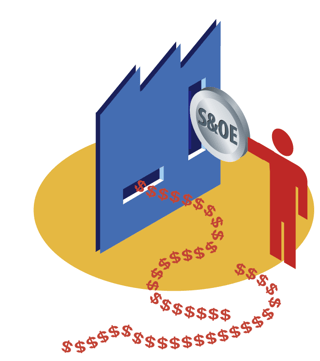How S&OE Adds Business Value
Nick Ostdick - August 31, 2017

 We’ve talked in a great length on this blog about the elements of effective global supply chain management and the implications thereof. But while these are important discussions to have as manufacturing companies work to expand their footprint and growth their customer base, at the end of the day the developments in supply chain management only really matter insofar as they add business value for these manufacturing companies. Advancements in procurement, production planning, job allocation, and transportation management must equal enhanced business value for each partner stage in a production network or else these aspects are simply window dressing designed to give the appearance of lean production principles.
We’ve talked in a great length on this blog about the elements of effective global supply chain management and the implications thereof. But while these are important discussions to have as manufacturing companies work to expand their footprint and growth their customer base, at the end of the day the developments in supply chain management only really matter insofar as they add business value for these manufacturing companies. Advancements in procurement, production planning, job allocation, and transportation management must equal enhanced business value for each partner stage in a production network or else these aspects are simply window dressing designed to give the appearance of lean production principles.
One of the most valuable assets manufacturing companies can utilize to increase business value is the idea of sales and operations execution (S&OE). Though something of a recent concept in global supply chain logistics, S&OE is a powerful piece of planning capability planners and managers can deploy to increase the efficacy of their planning and production programs, as well as enhance a number of other critical functions across the value stream such as resource and material procurement, optimized inventory management, and even job shop scheduling and job allocation.
S&OE also provides companies a method of checking the pulse of their overall supply situation in order to make critical adjustments for short, mid, and long-term success and viability. And because much of S&OE relies heavily on core industry drivers such as Industry 4.0, digitization, and other technological platforms, companies who embrace S&OE can often see significant enhancements of processes across other touch points of their value chain.
So, how exactly does S&OE help manufacturers add business value? What are the challenges manufacturing companies must overcome to add business value? These are the questions and concerns we’ll examine as we discuss how S&OE can add business value and enhance their standing in competitive, variant-rich industry.
Defining S&OE
Before we can explore how S&OE can help companies reduce supply chain costs, we must first operate under a fundamental understanding of S&OE and its place in a global supply chain management. As defined by Gartner, S&OE functions as a quick, short-term snapshot of the overall supply chain situation for planners and managers to make vital course corrections on a weekly basis to better create long-term strategies. S&OE acts as a demand planning supplement or safety net to detect the possibility of bottlenecks or breakdowns in larger-scale planning platforms. This in turn allows planners and managers to create and deploy solutions to these disruptions to enhance each touchpoint of a company’s overall value chain.
In addition, whereas more traditional S&OP strategy and annual planning often deal in forecasting, simulations, and other hypothetical supply and production scenarios, S&OE tracks actual demand and production metrics in real-time for a more accurate picture of the demand and production stages. By monitoring actual demand and production data via real line items and data, S&OE provides planners and managers an early warning system that helps ensure smooth production cycles in the mid and long-term. This also allows planners and managers to avoid costly bottlenecks or production breakdowns in the mid-range future by combatting issues today that could snowball tomorrow and beyond.
S&OE as a business value tool
Now that we understand S&OE as a critical element of demand planning strategy, we can examine S&OE as an important tool in creating business value and promoting lean, streamlined manufacturing principles. Because S&OE provides planners and managers with a glimpse of current supply situations in order to make adjustments in longer-term planning, the term ‘micro-agility’ is often applied to S&OE as it gives companies the maneuverability to effectively respond to sudden disruptions such as late shipments, inaccurate forecasting, or demand planning errors. S&OE also works to eliminate waste, reduce operational costs, and enhance business value by:
Combating the volatility of global supply chain logistics. Supply chain management in today’s global context is by nature a volatile business. S&OE and its ability to assess essentially in real-time the state of the supply chain and compare forecasts against actual operations provides companies with the responsiveness necessary to make in-the-moment adjustments and modifications to planning and production programs to cut complexity and combat a number of elements of volatility, such as bottlenecks, inventory overages or shortages, and transportation or routing concerns. S&OE provides companies the agility to improve scheduling accuracy and consistency, reduce waste of raw materials and resources, and provide enhanced levels of production and customer service without the need to expedite or reschedule orders to meet demand.
Enhancing E2E visibility and transparency. Because S&OE provides a window into the weekly supply chain situation, planners and managers can essentially work backwards or forwards in the demand planning process to increase visibility across the supply stream on a number of levels, be it daily, weekly, monthly, or even yearly. This structure elevates the supply chain and makes it easy for individuals across the value chain to expose weaknesses or inefficiencies at any stage of the process, which in turn makes supply chain streamlining and optimization a much easier and effective end result to achieve. In addition, because S&OE operates largely on real-time data rather than forecasted or predicted outcomes, companies are better equipped to make modifications or adjustments to planning and production programs based on variable rules and restraints, thus allowing for enhanced visibility into the inner workings of a company’s supply network.
Creating a space for detailed reporting and advanced analytics. We discussed before on this blog about the value of advanced analytics in fostering lean supply chain management strategies and putting mountains of data and reporting to good use for more effective, accurate planning. Because advanced analytics operate primarily in real-time and provide planners and managers with an immediate window into supply and production cycles, S&OE functions in perfect harmony with advanced analytics in giving planners and managers an outlet for massive amounts of real-time data and metrics. Essentially, advanced analytics is the gasoline for short-term planning and modifications to production programs while S&OE is the car that requires the fuel.
Put simply, S&OE is quickly transforming from simply an interesting concept or idea in global supply chain management to a necessary element in how manufacturing companies conduct their supply chain logistics and derive value from their operational platforms and philosophies. By helping companies foster lean planning and manufacturing strategies, S&OE helps manufacturers add business value to their value streams and provide high quality products and services for their customers.
LATEST POSTS
- Understand Circular Economy in The Manufacturing Industry
- How Can Industry 4.0 IT Integration Be Achieved Smoothly?
- The Significance of Order Sequencing in Discrete Manufacturing
- How to improve your Supply Chain Management: The Power of Control Towers
- Optimizing Human Resource Scheduling in Manufacturing: A Technological Approach



